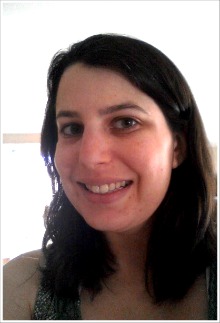High school math teacher Amy Komen describes how earning her master’s degree gave her more of an understanding of the deep critical thinking skills involved in learning, and teaching, mathematics.
Can you prove that an odd number exists?
Think about all of the numbers that surround you every day of your life. Most of us have never needed to think this deeply on the numbers we encounter, and we simply take them for granted and accept their existence at face value.
So when Amy Komen was asked to prove that an odd number exists in her Master’s in Mathematics Education program, she knew she had to re-examine her understanding of math theory.
“At first it seemed very daunting, but then I just sat down and thought about it,” Komen said. “Because I had to go so deep into that thinking, I’ve now trained myself how to think like that on other more basic levels with the kids.”
This deeper level of thinking is what drives Komen’s teaching practices today. As a high school mathematics teacher, Komen must break down complex mathematical concepts that are new to her students. With her advanced background in mathematics education, Komen finds she’s more easily able to answer that dreaded question high school students are so fond of asking: “Why are we learning this?”
Teaching Mathematics Using Reason
By instilling critical thinking skills in their students, math teachers ensure their future successes. The National Council of Teachers of Mathematics lists out several ways math teachers can instill these skills.
- Select tasks that develop students’ mathematical reasoning, skills, and knowledge
- Create a positive classroom environment where discussion is encouraged
- Organize discourse that allows students to reason and understand what they are doing
- Use assessments that promote sense making and reasoning by identifying student progress
- Use assessments that promote sense making and reasoning by identifying student progress
Source: The National Council of Teachers of Mathematics
“It makes the kids more interested in the subject when I can be like, ‘here’s what’s really happening, this is why you’re learning it.’ They don’t seem to hate math as much as they used to,” she says with a laugh.
Komen attributes much of her improved communication skills to her master’s degree program, where she says she received training on how to explain her teaching goals to her students. Improved communication between her and her students means more time spent enjoying math, and less time spent stumped on a frustrating question.
“I’m able to talk to them more about what’s going on,” Komen said. “It allows for more discussions in the classroom and I can get to know the kids much better. It just makes the class more fun for them and they learn at the same time.”
Before earning her master’s, Komen had a bachelor’s degree in mathematics with a secondary teaching credential. While she says her bachelor’s program just felt like working through the material and gaining content knowledge of mathematics, her master’s program was much more fulfilling.
Because Komen was already teaching while earning her master’s, she was able to apply new teaching techniques and lessons in the classroom immediately after learning them. By learning new material and integrating it into her classroom as soon as possible, she was able to see which techniques worked, and which ones didn’t.
“It forced me to look deeper into explaining basic things so children understand it,” Komen said. “I reference things I learned in those two years a lot in my teaching – on every level from algebra to pre-calc. I was able to use almost everything I learned within my career. I was able to use it the next day in class.”
Where Komen used to teach by the book and assume that was the best way to teach a lesson, today she analyzes and tries new methods of presenting material. Now, she says she “knows better,” and can look at a suggested way to solve a problem and think, “you know, there’s an easier way to do this.”
“It’s all about just reflecting and changing, and I really got all of that from my master’s degree – that thought process,” Komen said.
This process of reflection and change is what led Komen to develop her thesis paper on new methods of teaching “factoring” to students. Komen says factoring is one of the more difficult mathematical concepts to teach students, and many grow frustrated and give up. Her books described the problem-solving method as a kind of trial and error, but the wide variety of factoring problems means this method isn’t always effective.
Instead, Komen discovered a way for students to look at a factoring problem that is consistent despite the wide variety.
“It’s very systematic, no matter what the problem looks like, you do the same thing over and over and over again,” Komen said. “The kids really responded… and I was getting a lot higher grades from that rather than trial and error methods.”
Komen’s methods have proven successful, leading to more of her students to enjoy the class. It’s in these moments where Komen understands the true value of her degree.
“Just the fact that when I can get the majority of the kids to have that right answer on the problem, that’s when I know “okay, I did it, I can move on. It worked, and it feels awesome,” she said.



